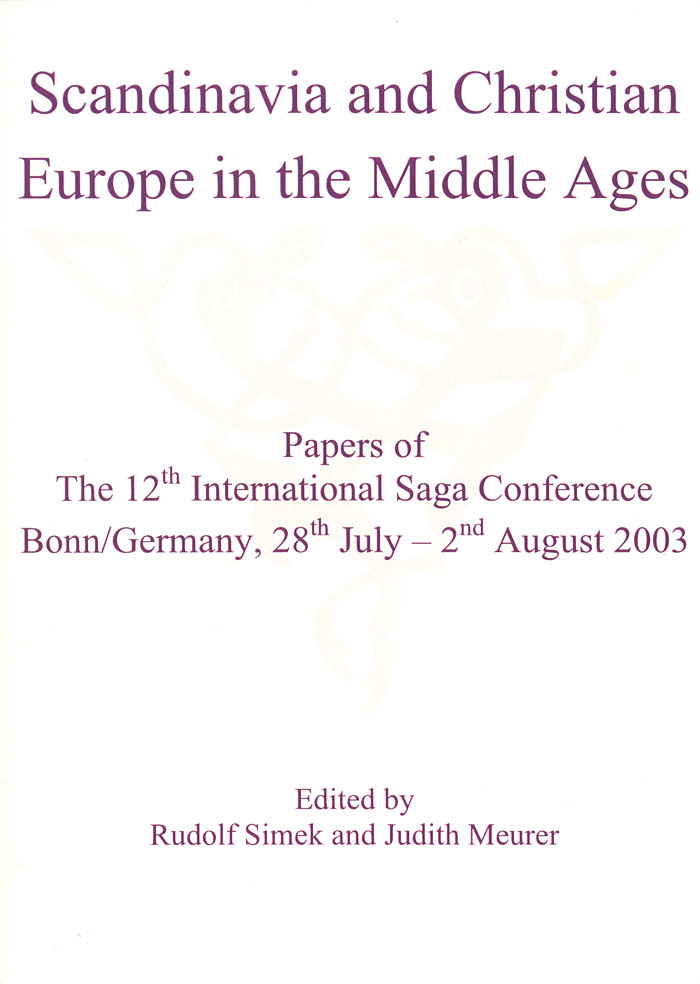Scandinavia and Christian Europe in the Middle Ages: Papers of the 12th International Saga Conference, Bonn/Germany, 28th July—2nd August 2003,
ed. Rudolf Simek & Judith Meurer (Bonn, 2005).
- Sirpa Aalto: Alienness in Heimskringla: Special emphasis on the Finnar.
- Ármann Jakobsson: Two old ladies at Þváttá and
history from below
in the fourteenth century.
- Sverre Bagge: Receiving, importing or producing culture? Research plan for the CoE on periphery and centre in Medieval Europe.
- Geraldine Barnes: The drama of faith west of Iceland.
- Simonette Battista: Old Norse hagiography and the question of the Latin sources.
- Bergljót S. Kristjánsdóttir: Gunnlogi and Hræfrakki: Two ditties in the shorter version of the Saga of Gísli.
- Régis Boyer: Bishop Guðmundr, once more!
- Kersti Bruvoll: An Old Norse version of the legend of St. Margaret of Antioch.
- Trine Buhl: Premises of literary history: On genre and narrative modes in the sagas.
- Aleksandr Busygin: Sverrir and St Óláfr: Symbology of power in a saga dream.
- Jesse Byock et al.: The Mosfell archaelogical project 2002 excavation.
- David Clark:
An eye for an eye?
: The Church and revenge in saga literature.
- Margaret Clunies Ross: Christian skaldic rhetoric in Einarr Gilsson’s Selkolluvísur.
- Margaret Clunies Ross and Tarrin Wills: The skaldic project.
- James Cochrane: Saying goodbye to the old religion: Dreaming of the rejected object of worship.
- Carla Del Zotto: Vom rex iustus zum Märtyrer: Das Heldenparadigma der christlichen Könige zwischen Hagiographie und Geschichte in den mittelalterlichen Quellen über die Bekehrung Skandinaviens..
- M. J. Driscoll: Postcards from the edge: An overview og marginalia in Icelandic manuscripts.
- Alison Finlay: The garter of St Óláfr: Links between poets and kings.
- Roberta Frank: Málsháttakvæði: A Norse poem from medieval Orkney.
- Kari Ellen Gade: Norse attacks on England and Arnórr Jarlaskald’s Þórfinnsdrápa.
- Richard Gaskins: Network dynamics in saga and society.
- Galina Glazyrina: On Heliopolis in Yngvars saga víðfǫrla.
- Gottskálk Þ. Jensson: The Latin fragments of Þorláks saga helga and their classical context.
- Guðrún Nordal: Ars metrica and the composition of Egils saga.
- Terry Gunnell: Höf, höll, goð(ar) and dvergar: Ritual space in the pagan Icelandic skáli.
- Elena Gurevich: On a narrative device in some Íslendinga þættir.
- Natalya Yu. Gvozdetskaya: Sanctity of a Christian king in Heimskringla in narratological perspective.
- Jan Ragnar Hagland: On Rǫgnvalds þáttr ok Rauðs in Óláfs saga Tryggvasonar en mesta and elsewhere.
- Anna Hansen: The precocious child: A difficult thirteenth-century Icelandic saga ideal.
- Helgi Þorláksson: Guðveldi og samtímasögur á 13. öld.
- Bengt Holmström: Kring Skotkonungs landamäre.
- Tatjana N. Jackson and Alexander V. Podossinov: The famous landvættir episode (ÓlTrygg33): A paradox of Icelandic religious consciousness?
- Henrik Janson: What made the pagans pagans?
- Judith Jesch: Old and new in Markús Skeggjason’s Eiríksdrápa.
- Jón Hnefill Aðalsteinsson: Sonatorrek: Religious ideas and preservation.
- Bengt R. Jonsson: Erik den Helige: Gammalt helgon i ny belysning.
- Marianne Kalinke: Hendreks saga og Kunegundis and conselsuality in marriage.
- John Kennedy: Scholarly book reviewing in the field of saga studies: Recent patterns and trends.
- Henning Kure: In the beginning was the scream: Conceptual thought in the Old Norse myth and the pagan past.
- Carolyne Larrington: Diet, defecation and the devil: Disgust and the pagan past.
- Annette Lassen: Gud eller djævel? Kristningen af Odin.
- Anatoly Liberman: Berserkir: A double legend.
- Lars Lönnroth: The transformation of literary genres in Iceland form orality to literacy.
- Inne Matyushina: On the imagery and style of riddarasögur.
- Bernadine McCreesh: An examination of the prophecy motif in Old Icelandic literature.
- John McKinnell: Völuspá and the feast of Easter (summary and examples).
- John Megaard: The man who did not write the Edda: Sæmundr fróði and the birth of Icelandic literature.
- Tomoaki Mizuno: Ring composition and circular narrative structure in Eddie poems.
- Gunnar Nordanskog: The
Volsung legend
in Norwegian stave church portals — meaningless decoration or conscious use?
- Richard North: Völuspá and the Book of Revelation.
- Ólafía Einarsdóttir: Olaf Tryggvason — Rex Norwegiae 994-999: Christian ethics versus Teutonic heroism.
- Carl Phelpstead: Masculinity and sexuality in sagas of Scandinavian royal saints.
- Rosemary Power: Monks and politics in the Norse kingdom of the Isles.
- Kees Samplonius:
Glaðr Eggþér
: Loki’s finest hour, or an outcast’s relief? Notes on the imagery of Vsp. 42-43.
- Jens Peter Schjødt: Oðinn’s rolle og funktion i den nordiske mytologi.
- Rolf Stavnem: Hvad er en sannkenning? Om en tvivlsom passage i Tredje Grammatiske Afhandling.
- Daniel Sävborg: Medelhavskulturen och eddadiktningens forhistoria.
- Matthew Townend: Like father, like son? Glælognskviða and the Anglo-Danish cult of saints.
- Úlfar Bragason: Sturlunga’s text of Prestssaga Guðmundar góða.
- Jens Ulff-Møller: The arithmetic in the royal land taxation of Iceland.
- Fjodor B. Uspenskij: Christliche und heidnische Namen im mittelalterlichen Skandinavien: Magnus als Name für ein illegitimes Kind des Herrschers.
- Vilmos Voigt: Hungarian glances to hagiography and the cult of saints in Scandinavia and in England.
- Tarrin Wills: Theories of the antiquity of runes.
- Kirsten Wolf: Kirkjubæjarbók: Codex AM 429 12mo.
- Yelena Sesselja Helgadottir: Men’s laments: Christianization and the image of masculinity.
- Kristel Zilmer: Representations of intercultural communication in the Sagas of Icelanders.
- Anton Zimmerling: Bishop Guðmundr in Sturla Þórðarson’s Íslendinga saga: The cult of saints or the cult of personalities.

